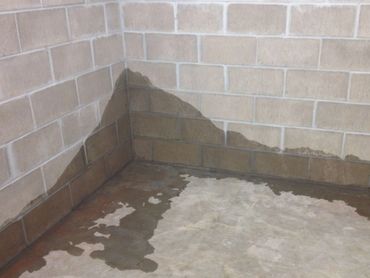Basement Waterproofing
Basement Waterproofing
Exterior Waterproofing
What Causes Basements To Leak After It Rains?


To understand this we have to briefly go over how a basement foundation is built.
First, an excavator will dig usually 8 feet deep in the ground the footprint of your home. Then, a perimeter trench in the soil at least 16 inches wide and 10 inches deep and the trench will be filled with concrete and rebar. This is the called the footing that your home sits on.
Secondly, the foundation wall will be built on top of the footing; typically concrete block or solid concrete. Finally, an exterior footing drain (a black perforated pipe) will be placed around the perimeter of the foundation, next to the footing, and then gravel will be placed on top of it. The exterior footing drain is designed to capture groundwater after a rain event and take it away from the foundation out to daylight. You can see the exterior footing drain on the picture. Some builders do not install exterior footing drains because certain cities and counties do not require it by code even though it is a good practice whether it's code or not.
QUESTION: If the grade around my house is pitched away from my house and my downspouts are extended out and away, why do I still have rain water leaking into my basement?
ANSWER: Remember, dirt is not waterproof, especially the dirt around your foundation. The dirt around your foundation is excavated fill soil that was broken up into billions of pieces therefore rain water flows through it easily and if you do not have an exterior footing drain or your existing footing drain is filled up full of mud, then the rain water has no where else to go but INSIDE YOUR BASEMENT
Call Crawl Space Techs for basement waterproofing, basement sealing, and to waterproof basements. We are out of Clarksville, TN

What Damages Do Leaking Basements Cause?
1).Building materials damage. A leaking basement will cause damage to finished drywall causing mold to grow quickly behind it, the finished flooring, and odors related to water damage.
2) Damage to personal property. Groundwater leaking in will cause damage to any furniture or boxes. It also makes the area unusable for any future storage.
3) Mold growth. Mold needs 60% humidity to grow and there will be constant evaporation from water on the ground and walls which will make it humid enough for mold to grow on your personal items and the floor framing above.
4) Foundation settlement. The constant rain water sitting at the bottom of your foundation causes your foundation to often be sitting on top of mud which can cause your foundation to settle or "squish down" in the mud. This can cause
5) Bowing foundation walls. Water build up behind the foundation walls after a rain event adds thousands of extra pounds of force to your foundation walls that it was not designed to handle. This will cause horizontal cracks and inward bowing of the foundation wall.

What Are All My Repair Options?
1) Extend the downspouts.
No warranty. Does not address rain water seepage around the entire property through the dirt.
2) Regrade the soil around the house.
No warranty. Dirt is not waterproof.
3) Exterior basement waterproofing
First, any landscaping, concrete, decks, or AC unit that is in the way has to been removed and replaced last. An excavator is used to dig down 8 feet to the bottom of the foundation around the house. A new rubber membrane or coating is installed on the exterior foundation wall. A new footing drain is installed with 2-3 feet of gravel on top of it. The remaining is backfilled with soil. Excess soil is hauled off and moved someone else on the property. Over time dirty water still enters the new exterior footing drain so it will still slowly fill up with soil again. 1 year warranty on the new exterior footing drain. Usually to do exterior waterproofing around an average home costs over $20,000.
4) Interior drainage pipe and a sump pump
This system carries a lifetime warranty that rain water won't get past our drainage. Drainage is installed under the basement floor taken to a sump pump. First the basement floor around the perimeter needs to be jackhammered to create a trench. Weep holes are drilled into the cinder block cavities to prevent them from filling up full of rain water. Then a layer of filter fabric is laid in the trench to mitigate the drainage pipe filling up with dirt. A white plastic wall liner is added to the foundation wall so any wall leaks will be directed down to the drainage pipe system. Finally concrete is added to restore the floor flush. This option usually costs between $3,000 to $10,000 depending on how much drainage pipe is needed in the basement to keep it dry.

Current Google Reviews
Current Facebook Reviews
Need A Free Estimate? Contact Us!
Hours
Mon | 08:00 am – 05:00 pm | |
Tue | 08:00 am – 05:00 pm | |
Wed | 08:00 am – 05:00 pm | |
Thu | 08:00 am – 05:00 pm | |
Fri | 08:00 am – 05:00 pm | |
Sat | Closed | |
Sun | Closed |


